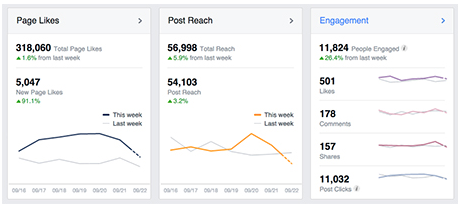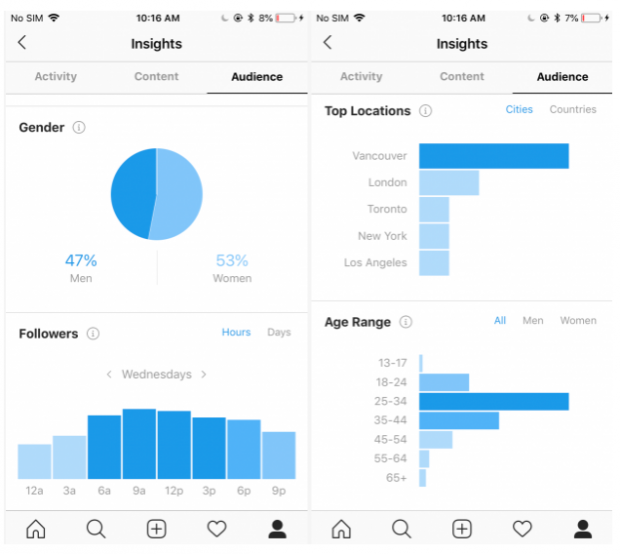Continue with some social media best practices you need to know…
8. Follow the social media ‘Rule of Thirds’
Why?
First, let’s talk about what to share.
- ⅓ share posts to promote your business, convert readers, and generate profits
- ⅓ share posts of ideas from influencers in your business (or like-minded companies)
- ⅓ share posts of personal stories to build your brand
Now, back to the why (for the ⅔ sharing).
Sharing out content shows your fans…
- You understand your industry
- You are collaborative
- Where you are positioned within the industry
Simple, right?
9. Respond to all comments and @mentions—promptly
Because if you do not, it shows you look lazy, unwilling, and all about you.
So get off your podium and into the dinner party—by listening, welcoming, and encouraging conversation. Like a great host.
Once you are on a podium, you orate—one-way communication.
However, at a dinner party, you converse—two-way communication.
Social media + mentions + comments + respond now (not later) = a relationship.
Right here’s an entire information to social media engagement to form healthier relationships for your social media accounts.
10. Don’t repost the same message across networks
I know, publishing the same (exact) message across your social channels seems efficient. Why reinvent (or rewrite) a piece multiple times versus one time?
However, like tip number 9 above, reposting is another method to look lazy and sloppy.
Instead, craft a new mess for every platform and post.
Sure, it takes more time and work. However, maybe not as much as you think. No need to begin from scratch—however, do make some tweaks.
It’ll pay off because people will see you as a brand that cares what it shares.
And it exhibits that you are paying attention.
Optimize content for each network. Tailor some things for your channel. Use the right vocabulary for your captions. It’s simple to imagine words that work on Snapchat might not have an opportunity on LinkedIn. And utilize the suitable (vs same) hashtags for each platform.
If not, you will look spammy.
Do not over post. Post frequently? Absolutely. Overposting might be hard to do on Twitter, however simple to do for Fb and LinkedIn. Different audiences have different tastes. Know all of them to appeal to them all.
Ignore some channels. Just do. Because sharing a cool new product may rock on Pinterest, however, flop on LinkedIn.
11. Use data to decide when and how often to update
When is the right time to post?
It depends upon the social network. People may be on LinkedIn during regular workday hours, however, Instagram is more of a leisure time platform.
Now, how often should you publish?
That’s hard to say, in general. However, create social media reports to track outcomes for who are engaging with your brand and posts. So you could make your choices based on data, not hunches.
12. A/B test your messaging
A/B testing (a.k.a. split testing) permits you to check small variations of your messaging to learn what works greatest for your audience.
How?
- Separate your audience into two random teams
- Show a different message variation to each group
- Compare the responses to your chosen metrics
They key—change one thing at a time. Otherwise, you are back to guessing when you change multiple aspects of the message.
What to test, you may be considering?
Post text. Consider some of these for your A/B testing:
- A quote vs a key statistic
- The length of the post
- Use an emoji
- Ordered versus unordered bullets
- Variations on punctuation
- Tone of voice, say casual versus formal, passive versus active
Here’s how Ikea did it.
Call-to-action. CTAs are important, you are asking readers to take action. Change it up to see what works greatest. For instance, ‘Use App’ versus ‘Install Now’. Simple to do, simple to see outcomes.
Use of picture or video. The analysis shows photos and videos perform greatest. Fine, however which of these work greatest? Try it and see, to go from theory to proof for your posts. For example, test:
- Text only versus posts with a picture or video
- Regular picture versus animated GIF
- Pictures of people or products versus graphs or infographics
- Length of video
13. Use the right tools
There are loads of tools and apps to do social media right.
Of course, there are the major networks like Fb, Twitter, YouTube, and Instagram. You should begin there—at least with the ones which are right for your brand and target audience.
Then you could look to apps to take your posts and content to the next level. Here are a few:
- Planoly is an Instagram visual planner to see your grid before you publish.
- Canva is an app to (easily) make stunning photos for your posts. No graphic design experience required. Here’s a guide to social media image apps.
- Story Slicer permits you to cut, edit then post videos for Instagram, Fb, Whatsapp, or VK stories. It’s simple to use, for the novice or professional videographer.
- Campsite. The issue: you only get one link on your social profiles. The answer: a collection of links with photos to send users to exactly the right place.
14. Measure results and adjust your strategy as needed
For your social media… Have you identified your goals? Then defined the right metrics? Same for your KPIs?
Yes? Good one.
Then the next step is to find out when you are earning more than you are spending on social media. By collecting data from your accounts and campaigns to track and enhance performance—analytics.
Facebook has an analytics dashboard. Utilize it to view followers, likes, reach and engagement for your pages and posts. Notice the changes before and after a campaign.
Want to increase some adverts, however, not sure which ones? Use the Promotions section to figure that out. There’s more, however, you get the idea.
Twitter also has a dashboard to take a look at the info, month-to-month. Like, top tweets, followers, and mentions. See too, engagements, impressions, and promotions for your tweets for a given time period.
Twitter also shows demographics for your audience. Utilize this to compare your fans and how they differ.
Instagram gives analytics for business profiles. More than just content, gain insights about who your followers are, once they are online, and more.
For your account understand:
- Impressions: the number of times your posts were shown on screen
- Reach: the number of unique post views
- Site Clicks: The number of clicks on the link included in your profile
- Profile Visits: The number of times your username is clicked on
You will discover related dashboards for LinkedIn, Pinterest, and Snapchat.
Use these tools to see what is working and what’s not, so you could see and adjust to get more of the former.
There you go. Some tools, rules, and clues for making your social media best practices.






